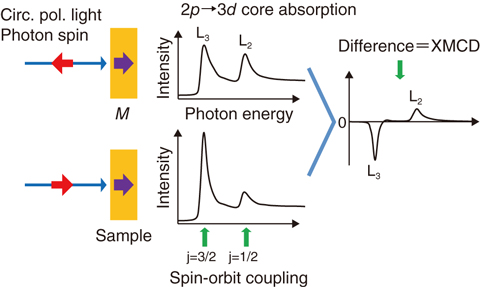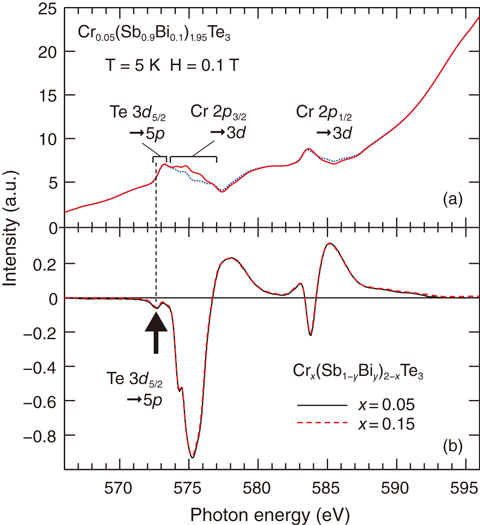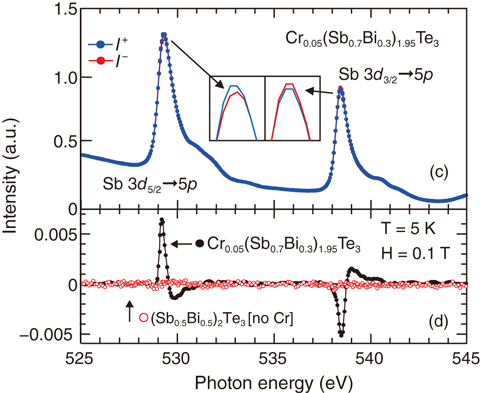
Fig.5-22 XMCD schematics in core-level absorption

Fig.5-23 Experimental spectra of Crx(Sb1−yBiy)2−xTe3 at the Cr 2p→3d and Te 3d→5p edges

Fig.5-24 Experimental spectra of Crx(Sb1−yBiy)2−xTe3 at the Sb 3d→5p edges
Recently, topological insulators (TIs), characterized as bulk insulators with conducting states on their surface, have attracted attention globally owing to the quantum-anomalous Hall effect (QAHE) discovered in ferromagnetic Cr-doped (Sb,Bi)2Te3 TI at very low temperatures. The QAHE enables electric currents to flow with little energy consumption. To realize QAHE at room temperature, unmasking the underlying physics behind the ferromagnetism is required. We have performed an X-ray magnetic-circular dichroism (XMCD) experiment at the BL23SU of SPring-8 and revealed the origin of ferromagnetism by detecting not only the magnetic moment of Cr 3d electrons but also those of “nonmagnetic” Sb and Te 5p electrons. The XMCD spectrum is defined as the difference between the core-absorption spectra (XAS) of the left- and right-handed circularly polarized light, as schematically shown in Fig.5-22.
Fig.5-23(a) shows the Cr 2p→3d XAS spectra of Crx(Sb1−yBiy)2−xTe3 (x = 0.05, y = 0.1, TC = 15 K) measured at a magnetic field of 0.1 Tesla and a temperature of 5 K. Fig.5-23(b) shows the XMCD spectra for two different Cr contents (x = 0.05, 0.15). We find that the signals are negative and positive at the 2p3/2→3d and 2p1/2→3d edges, respectively, which signifies that the Cr 3d electrons are responsible for ferromagnetism. As indicated by an arrow in Fig.5-23(b), a negative signal at the Te 3d5/2→5p edge below the Cr 2p3/2 edge is observed. This tells us that the magnetic moments of the Te 5p and Cr 3d electrons are coupled in an antiparallel manner.
Fig.5-24 shows the Sb 3d→5p XAS (c) and the associated XMCD (d) spectra for Cr0.05(Sb0.7Bi0.3)1.95Te3. Here, we find positive and negative signals at the 3d5/2→5p and 3d3/2→5p edges, respectively. No XMCD spectrum is found for the sample without Cr doping [(Sb0.5Bi0.5)2Te3]. The result tells us that the Sb 5p moment is aligned parallel to the Cr 3d magnetic moment. Therefore, we confirm that the Cr 3d magnetic moments are mediated by the Te and Sb 5p holes, which work as a glue for the largely separated Cr spins in the crystal and should be a key to the ferromagnetism of magnetic TI Crx(Sb1−yBiy)2−xTe3.
Our results will open the way to the future material design of QAHE systems and may provide a guideline for practical application of next-generation ultra-low power-consumption devices using TIs.